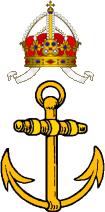Royal Gotzborg Navy
| This article is a work in progress. As a result, it may be missing entire sections of information at this time. |

History
Structure
Royal Submarine Service
Dockyards, Bases & Other Installations
The Royal Navy maintains numerous naval installations which act as the home bases, training centres, repair & construction facilities and command centres. These installations help to support and maintain the Royal Navy in its operations on a regular basis and are an important component of the Armed Forces support structure. While the Royal Navy maintains its own shipyards to repair, overhaul and construct certain types of vessels, there are no limitations upon private shipyards building or constructing vessels in Gotzborg.
For the purposes of organization, installations are named according to their size. First are the Dockyards, which are large bases which include training facilities, dockyard for the repair and construction of vessels, Headquarters units, fuelling facilities, armouries, and supply depots. Dockyards are usually built in heavily defensible positions protected by contingents of Naval Marines, Coastal Artillery emplacements and assigned Dockyard naval forces charged with the patrol and protection of the Dockyard area. Dockyards are always referred to as such with the HRM before the base type and the name of the base, for example, HRM Dockyard Reichlau (His Royal Majesty's Dockyard Reichlau).
Next in size comes the Base. The base, while smaller than the Dockyard, usually has many of the same facilities although on a smaller scale. Defence will likewise be less than what would be found at a Dockyard. There are limited repair and outfitting facilities and usually little to no construction facilities, those that do have construction facilities are usually for construction of vessels around 500 tonnes. Bases are referred to much like dockyards, for example HRM Naval Base Ganden.
The Naval Station is next and is subdivided into two types, regular or Colonial. A regular Naval Station is a permanent installation while a Colonial Naval Station is usually a temporary facility intended to support only a specific mission or effort being made at the time. A Naval Station, whether regular or Colonial is a facility which does not have any construction facilities and whose repair capabilities are very basic. Defensibly, a Naval Station only has assigned a contingent of Naval Marines assigned for base protection and does not have coastal artillery available. Naval Stations are normally not built into a defensible area and sea-side protection is often provided by the units assigned to the area as opposed to having its own units, however some Stations do employ small cutters, inspection vessels and motor launches. Supply facilities are minor but can offer replenishment for a vessels artillery, food and associated needs but would not be able to replenish a major fleet or large squadron of ships for instance. All Naval stations provide refuelling facilities however these are limited and cannot provide for simultaneous replenishment of vessels like a Base or Dockyard can. Colonial stations are most often not attached directly to mainland Gotzborg and are hence dependent upon the regular resupply of provisions and fuel to maintain their effectiveness.
The smallest installation is the Naval Establishment which is even sometimes not even located on a coastal area! The Establishment can be considered more like a 'whistle-stop' and provides only the most basic of communications, docking, fuelling and supply facilities and in some cases, none of those. Inland, the establishment is a unit used for the recruitment and training of naval personnel as well as acting as the centre for all Naval Reserve activity.
- HRM Dockyard Reichlau (RN Headquarters);
- HRM Dockyard Aremberg;
- HRM Dockyard Abrantes;
- HRM Dockyard Plauen;
- HRM Naval Base Ganden;
- HRM Naval Station Markham;
- HRM Naval Station Avondale;
- HRM Naval Station Friedrichsnachts;
- HRM Naval Station Lusatia;
- HRM Naval Station Ouestlach;
Fleet & Equipment
Main Article: Ships of the Royal Gotzborg Navy
The largest component in the Royal Navy is the fleet, which is composed of both Flotillas and Squadrons depending upon the composite unit. The smallest combined unit in the Navy is the Squadron, which has no set number of ships required, but is instead formed by order of the Naval Staff.
Originally encompassing ten (10) ship classifications, the Royal Navy now includes fourteen (14) ship classes (types), following the addition of dreadnoughts, battle cruisers, aircraft carriers, and submarines since 2006. Within each class, ships are differentiated into ratings (or sub-classes) ranked according to superiority. As ships age and new ships of improved strength are commissioned, these ratings are reviewed and changed as required. The ship classes currently employed are:
- Dreadnought (DN);
- Battleship (BB);
- Battlecruiser (BC);
- Aircraft Carrier (CV);
- Heavy Cruiser (CH);
- Armoured Cruiser (CA);
- Light Cruiser (CL);
- Protected Cruiser (CC);
- Frigate (FF);
- Destroyer (DD);
- Gunboat (GB);
- Submarines;
- Fleet Supports;
- Special Service Ships;
On April 19, 2013, His Royal Majesty announced the submission of the Naval Surface Fleet Assessment Committee report to the Naval Staff[1]. The Committee's proposal recommended the elimination of the armoured cruiser and protected cruiser classes, with each affected ship being reclassified and refitted as a heavy or light cruiser, should it not be identified for decommissioning. It also recommended that the Royal Navy identify and plan for the construction of new classes to ensure the integrity of the Strategic Naval Plan. As of 2017, the recommendations remain unadopted.
Rank Structure
There are a total of thirteen (13) ranks within the Royal Navy, ranging from Midshipman to Grand Admiral (King). All members of the Royal Navy are granted a rank by His Royal Majesty and all ranks except Midshipman are commissioned. His Royal Majesty is the Commander-in-Chief of the Royal Navy.
Uniforms
- ^ RN Surface Fleet Transition Plan: http://gotzborg.com/forum/showthread.php?tid=879, accessed 2017-06-02.